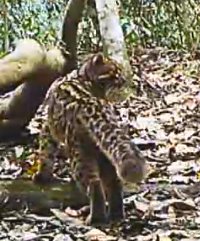The Marbled Cat (Pardofelis marmorata)

Technical Briefing: This elusive small wild cat (Pardofelis marmorata) is found in south and south-eastern Asia. It has a uniquely marbled coat pattern, from which its name is derived (Marmora is 'marble' in Latin.) The first recorded sighting of a Marbled Cat was by William Charles Linnaeus Martin in 1836. A year later he described his findings in the Proceedings of the Zoological Society of London (1837). Martin records the Marbled Cat as being found in Brunei Darussalam, Cambodia, China, India, Indonesia, Laos, Malaysia, Burma, Nepal, Thailand and Vietnam.
Originally placed in the Pantherine subfamily within the family Felidae, following genetic analysis the cat has now been rehomed with the Pardofelis genus, species p. Marmorata. Close relatives are Asian Golden Cats and the Bay Cat.
The Marbled Cat in its Environment: Marbled cats like to live in rainy, mixed deciduous-evergreen tropical forests at an elevation of 1,000 to 1,200 m (3,300 to 3,900 ft). The cats are well equipped for life in the trees. Their thick coats range from dark grey-brown through yellowish grey to red-brown and the marbled coat pattern is superb camouflage. Their large paws are webbed and their claws can be completely sheathed.
The most remarkable part of their bodies is a tail which is often longer than the rest of the cat. This long tail definitely helps with tree living because it provides additional balance. Most other types of cat - even those that like to live among the branches - canít imitate the Marbled Catís feat of running down tree trunks head first. Only Clouded Leopards (Neofelis spp.) and Margay cats (Leopardus wied) come close.
Marbled cats are around the size of domestic cats, and pretty much the same weight (between 3 and 5 kg). But their unusually large canine teeth resemble those of big cats. This undoubtedly helps when hunting larger prey. Indeed an individual Marbled Cat has been seen stalking a juvenile Phayre's leaf monkey - a species which outsizes the Marbled Cat by a factor of three. Mostly, however, the Marbled Cat is a menace to smaller denizens of the trees - birds, lizards, squirrels and other rodents.
In May 2000 a Marbled Cat was trapped in Thailand and fitted with a radio-tracker. This very first high-tech Marbled Cat revealed that it had an overall home range of 5.8 km2 (2.2 sq mi). Not surprisingly, this individual was most active at night and twilight (pre-dawn and dusk).
A few Marbled Cats have been bred in captivity. The gestation period was between 62 and 88 days. The mothers usually produced two kittens. As with domestic cats, the marbled kittens open their eyes at around 12 days and start to eat solid food after two months. This is also the time when kittens started to experiment with their future lives of tree climbing. In captivity, that life is around twelve years.
Finding a Rare Breed: The Marbled Cat is shy, elusive and extremely well-camouflaged. This makes it hard to come up with reliable figures for the number of these cats in the wild. In the most extensive study, published in 2016 (see ref below), passive infrared digital cameras were placed in 10 different locations in areas where Marbled Cats might be expected to live. The cameras operated between May 2007 and December 2013. In many locations disappointingly few Marbled Cats turned up for a photo-call, but in three areas scientists collected enough pictures to make an estimate of the density of the Marbled Cat population.
The Spatially Explicit Population Model which the researchers used combines a population simulator with a map of the landscape. The locations of different habitats, individuals, and other items of interest are built into the model, which makes it easy to study how changes in the landscape affect the density of the population.
The largest number of Marbled Cats were seen in the lowland Danum Valley Conservation Area in Sabah, Malaysia - 438 square kilometres of relatively undisturbed tall hardwood tropical trees. In this area there were about 19.6 animals in every hundred square kilometers.
However cameras from Tawau Hills in Malaysia captured only 7.1 cats per 100 km2. Perhaps the most surprising results came from the selectively logged, lowland Tabin Wildlife Reserve - a large rainforest also in Sabah, Malaysia. Despite the logging, the density of the Marbled Cats appeared comparable to the other two areas, with 10.5 cats per 100 km2.
This last figure gives hope that Marbled Cats might be adapting relatively well to a changing environment. Nevertheless, given that so few Marbled Cats appeared on cameras placed elsewhere, it may be that the estimates for those in areas where they did show up are on the high end of the scale.
Reference
Hearn, A. J., Ross, J., Bernard, H., Bakar, S. A., Hunter, Luke T. B., Macdonald, D. W. "The First Estimates of Marbled Cat Pardofelis marmorata Population Density from Bornean Primary and Selectively Logged Forest". PLOS ONE (2016) 11(3). https://journals.plos.org/plosone/article?id=10.1371/journal.pone.0151046

